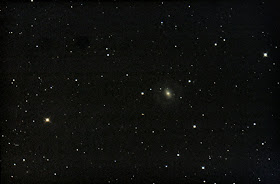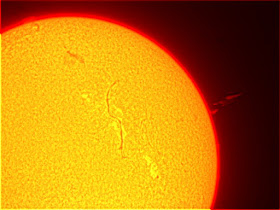This would be an impossible conjunction, mainly because of the fact that the bluish star, zeta Boötis is out of the plane of the Solar system. Also, the brightness of Mars and the star is a bit fainter than that of Venus. All these were taken on the evening of Thursday 26th April using the Imaging Source DBK camera with a 2x barlow lens on the Celestron 9.25 inch SCT. Mars was particularly sharp, even at a scale of about 0.25 arc seconds per pixel, as it was nice and high in the sky. Zeta Boötis is a double star challenge, I wanted to see if I could visibly separate two stars less than 1 arc second apart. Given Mars is about 10 arc seconds across, I think I can see a fainter star, just above the main bright one. It's not clear or fully seperated but elongated slightly at what looks like a Position Angle of about 350º. Is this right? I think I had the camera orientated correctly so top is approximately North. I'm now going to check it out, and see how wrong I am (I'm trying to be scientific and not biased about it). Anyway enjoy the lovely composition!
Update on z Boo: I was wrong. It turned out I'd tried to detrail the star a little, just 1 or 2 pixels, but the trail was in fact the pair, and they were equal in brightness on a East West alignment. So I had (unscientifically) assumed my raw data was in need of a correction, and in so doing, hid the possible detection of the second star! It is apparently only 0.5" away. Here's the original pic.
Photography of "far away things" - space, but I may also want to include anything in our atmosphere or just nice landscape shots.
Friday, 27 April 2012
The edges of the lunar landscape
Here, we are peering slightly around the north east (top right) side of the moon, due to it's slightly wobbly path around us here on Earth. This libration effect has made the lunar sea Mare Humboldtianum visible behind the crater Endymion. The slight fuzziness of the image is because the jet stream was over us again, which resulted in not so good seeing conditions. Also I was looking through a fairly large air mass. It was taken with the society's Imaging Source DBK camera using a 2x barlow lens, on a Celestron 9.25". I tilted the camera and overlaid two images that were quite close. Each image was a composite of several hundred movie frames, stacked in Registax 5.1. For fun (heh, geek fun) I also made a colour version, where I corrected the colour cast, blurred the hue channel and ramped up the saturation.
Sunday, 8 April 2012
Ring galaxy
 Now here's a far away thing. NGC 5701. I heard this 'little' thing had a detached ring around it so I thought I'd add it to my itenerary one night imaging at the observatory. I got 13 pics of 30 seconds each at f/3 on the 20", and appropriate darks. I later applied some previously taken flats, which haven't done a perfect job. You can see a couple of dust doughnuts as I've had to ramp up the contrast of the shadows to show the faint ring around this galaxy. When I first looked at the images on my camera, I was a little disappointed to see just a normal spindle-like shape, but an interesting bar across the middle nevertheless. There was no evidence of a ring among the light pollution. Even after stacking the images, it had to be teased out in the process of processing, so I'm presenting this image with camera readout stripes and 'noise' across it just so you can see this fascinating feature. The galaxy is classified as an SBOa-R (R for ring), and the central core comprises of some tightly wound spiral arms. The ring is just connected to the central part of the galaxy at one point, not easy to see in this picture. This galaxy would be an ideal candidate for the Atik when it is higher.
Now here's a far away thing. NGC 5701. I heard this 'little' thing had a detached ring around it so I thought I'd add it to my itenerary one night imaging at the observatory. I got 13 pics of 30 seconds each at f/3 on the 20", and appropriate darks. I later applied some previously taken flats, which haven't done a perfect job. You can see a couple of dust doughnuts as I've had to ramp up the contrast of the shadows to show the faint ring around this galaxy. When I first looked at the images on my camera, I was a little disappointed to see just a normal spindle-like shape, but an interesting bar across the middle nevertheless. There was no evidence of a ring among the light pollution. Even after stacking the images, it had to be teased out in the process of processing, so I'm presenting this image with camera readout stripes and 'noise' across it just so you can see this fascinating feature. The galaxy is classified as an SBOa-R (R for ring), and the central core comprises of some tightly wound spiral arms. The ring is just connected to the central part of the galaxy at one point, not easy to see in this picture. This galaxy would be an ideal candidate for the Atik when it is higher.
Thursday, 5 April 2012
CME
 I popped over the obs. this afternoon and did some imaging of the sun with the Gordon-cam, a portable DBK colour camera designed to run in planetary video imaging mode. This was attached to our Coronado 40mm Solar Max Hydrogen-alpha telescope. I aimed for 1000 frames per video. For this image, I adjusted the exposure/gain to make red saturated & exposed for flares, and green nearly saturated & exposed for surface detail. Even though green should not be detecting light in H-alpha imaging there will be some transmission of red light through the green filters on the camera's sensor. Very useful - 2 exposures in 1, and a nice coloured picture. Oh and I had to de-interlace the picture and reaverage the even and odd rows, then sharpen, which could be fixed with a monochrome sensor (DMK). I just thought I'd post this as the Sun looked surprisingly detailed, with a Coronal Mass Ejection 10-15 earth diameters long. In this image, celestial north should be up, so solar north should be tilted according to the ecliptic angle of about 20 degrees clockwise. As the solar x-ray activity was low, I wasn't expecting much, and was really surprised to visually see these huge stripes across the sun, and a healthy load of flare activity around the limb.
I popped over the obs. this afternoon and did some imaging of the sun with the Gordon-cam, a portable DBK colour camera designed to run in planetary video imaging mode. This was attached to our Coronado 40mm Solar Max Hydrogen-alpha telescope. I aimed for 1000 frames per video. For this image, I adjusted the exposure/gain to make red saturated & exposed for flares, and green nearly saturated & exposed for surface detail. Even though green should not be detecting light in H-alpha imaging there will be some transmission of red light through the green filters on the camera's sensor. Very useful - 2 exposures in 1, and a nice coloured picture. Oh and I had to de-interlace the picture and reaverage the even and odd rows, then sharpen, which could be fixed with a monochrome sensor (DMK). I just thought I'd post this as the Sun looked surprisingly detailed, with a Coronal Mass Ejection 10-15 earth diameters long. In this image, celestial north should be up, so solar north should be tilted according to the ecliptic angle of about 20 degrees clockwise. As the solar x-ray activity was low, I wasn't expecting much, and was really surprised to visually see these huge stripes across the sun, and a healthy load of flare activity around the limb.



